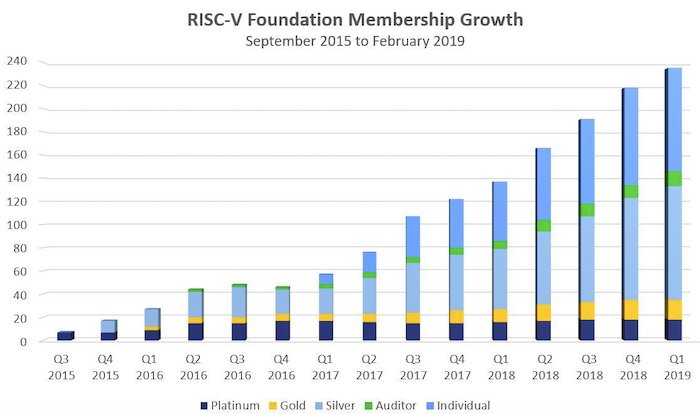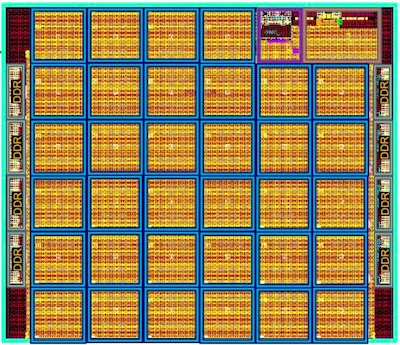Founded in a UC Berkeley lab over 10 years ago, the RISC-V Foundation is known for its revolutionary success in building an open-source ISA.
At first, the project was aimed at low-power embedded processors, but the ISA has evolved significantly since those days. Since its inception, the project has grown to over 2,000 members, formed a strategic partnership with the Linux Foundation, and powered hundreds of industry and academic projects.

RISC-V Foundation membership growth. Image used courtesy of Business Wire
Now, the next step in the RISC-V evolution is a very ambitious one: developing RISC-V for high-performance compute (HPC). Specifically, RISC-V International announced that it would like to extend its reach into the world of data centers with a focus on applications including machine learning.
HPC Calls for Accelerators and Heterogenous Platforms
Historically, HPC required the collaboration of two main methods of information processing: serial and parallel.
The serial processing unit usually consists of CPU cores to take care of housekeeping tasks like operating systems and very basic applications. The parallel processing unit tends to consist of multiple CPUs or GPUs aggregated in clusters with memory modules through high-bandwidth interconnects.
In recent years, two major trends in HPC have been increased use of accelerators and heterogeneous platforms.

The NVIDIA Jetson Xavier NX is an example heterogeneous platform. Image used courtesy of NVIDIA
Accelerators have found great value lately thanks to applications like ML with workloads that are better handled by ASICs than GPUs or CPUs. Relying on ASICs has, in turn, led to the rise of heterogeneous computing: computing architectures that combine CPUs, GPUs, and accelerators together.
Why RISC-V for HPC?
This increased demand for custom computing platforms has positioned RISC-V well for its foray into HPC.
The open-source, customizable nature of the project affords engineers significant resources and flexibility to take what already exists and create a unique solution for their workload.
That's why RISC-V has struck such popularity among startups, including those venturing into the data center market. A prime example of this is the ET-SoC-1 ML inference chip from Esperanto, an IC which leverages RISC-V to create a custom, 1,000+ core system meant specifically for data center inference.

The ET-SoC-1 is a RISC-V-based HPC IC. Image used courtesy of Esperanto
Another startup, Ventana Micro Systems Inc. also develops multi-core RISC-V chiplets geared for data centers. These CPUs are said to include extensible instruction set capability.
Intel Shows Interest in RISC-V-based Servers
While there are as many as an estimated 200 startups developing AI/ML—some of which rely on RISC-V—these smaller companies still face giants like Intel as competition. In a 2019 interview with ITPro Today, Western Digital's Martin Fink voiced skepticism in a future of data center-facing RISC-V processors.
"[S]ome people think data center means building a Zeon class processor, but instead of having x86 cores it has RISC-V cores,” he explains. “I have no interest in building that; I don’t see the point in doing that. Intel’s pretty much done a really good job. Let’s let them keep doing what they’re doing right.”
But recent reports from Bloomberg suggest that even Intel may be taking interest in RISC-V for its server market. In June, Intel purportedly offered to acquire SiFive, a RISC-V chip designer, for more than $2 billion. It's possible that Intel's interest in SiFive—and RISC-V by extension—stemmed from NVIDIA's attempt to acquire Arm last year. SiFive is an appealing backup plan for Arm customers concerned that the NVIDIA deal would compromise their current access to Arm chip licenses and process designs.
RISC-V Announces HPC Plans
In order for RISC-V to pursue HPC, the RISC-V Special Interest Group on High-Performance Computing (SIG-HPC) was formed.
From the group’s website, the goal of SIG-HPC is to enable workloads including weather forecasting, computational fluid dynamics, material science, and much more on their ISA. In order to do this, the group is starting new initiatives such as mapping the HPC software ecosystem to RISC-V. This includes discovering which open-source libraries, benchmarks, and applications currently work out-of-the-box on the RISC-V ISA and may be useful tools to leverage.
At the moment, RISC-V SIG-HPC consists of 141 members along with 10 active research, academia, and industrial members from a wide range of organizations.
